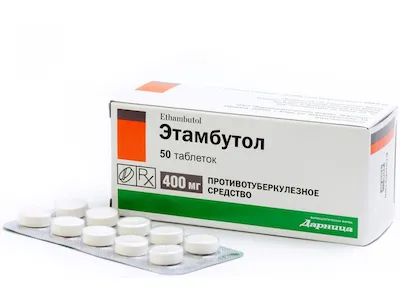Description
Etambutol (Ethambutol) Tablets 0.4 №50
Ingredients
Each tablet contains 0.4mg of Ethambutol.
Mechanism of Action
Ethambutol inhibits the synthesis of arabinogalactan in the mycobacterial cell wall, which disrupts the formation of the cell wall and leads to bacterial death.
Pharmacological Properties
Ethambutol is a bacteriostatic antimycobacterial agent that specifically targets Mycobacterium tuberculosis.
Indications for Use
Etambutol is indicated for the treatment of tuberculosis, particularly when used in combination with other anti-tuberculosis medications to prevent resistance development.
Contraindications
Etambutol should not be used in patients with optic neuritis or known hypersensitivity to the drug. Caution is advised in patients with renal impairment due to the potential for drug accumulation.
Side Effects
Common side effects of Etambutol may include optic neuritis, gastrointestinal disturbances, and skin rash. Regular monitoring for visual changes is recommended during treatment.
Usage Instructions
The usual adult dosage of Etambutol is 15-25 mg/kg of body weight daily, not exceeding 2.5g per day. It is generally taken orally once a day on an empty stomach.
Benefits Compared to Analogues
Etambutol offers the advantage of being effective against Mycobacterium tuberculosis while demonstrating a favorable safety profile compared to some other anti-tuberculosis drugs.
Suitable Patient Groups
Etambutol can be used in various patient groups, including adults, children, and the elderly, with appropriate dosage adjustments based on individual factors such as renal function and body weight.
Storage and Shelf Life
Store Etambutol tablets in a cool, dry place away from moisture and sunlight. Check the expiration date on the packaging and do not use the medication if expired.
Packaging Description
Etambutol tablets are typically packaged in blister packs of 50 tablets each, ensuring convenient and accurate dosing for tuberculosis treatment regimens.
Clinical Evidence and Proven Effectiveness
Clinical studies have demonstrated the efficacy of Ethambutol in the treatment of tuberculosis, particularly in multidrug-resistant cases. Research published in the International Journal of Tuberculosis and Lung Disease supports the use of Ethambutol in combination therapy for improved outcomes.
Additional Information
Etambutol’s mechanism of action disrupts mycobacterial cell wall synthesis, effectively combating tuberculosis bacteria. Clinical trials have confirmed its tolerability and role as a cornerstone in tuberculosis treatment protocols.





